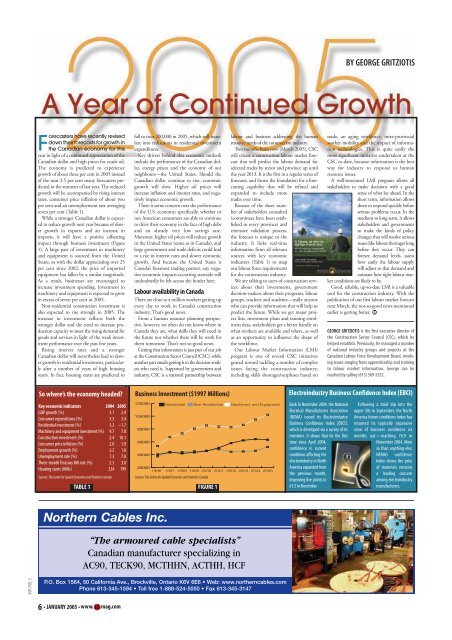January 2005.pdf - Electrical Business Magazine
January 2005.pdf - Electrical Business Magazine
January 2005.pdf - Electrical Business Magazine
- No tags were found...
You also want an ePaper? Increase the reach of your titles
YUMPU automatically turns print PDFs into web optimized ePapers that Google loves.
BY GEORGE GRITZIOTISForecasters have recently reviseddown their forecasts for growth inthe Canadian economy for thisyear in light of a continued appreciation of theCanadian dollar and high prices for crude oil.The economy is predicted to experiencegrowth of about three per cent in 2005 insteadof the near 3.5 per cent many forecasters predictedin the summer of last year. The reducedgrowth will be accompanied by rising interestrates, consumer price inflation of about twoper cent and an unemployment rate averagingseven per cent (Table 1).While a stronger Canadian dollar is expectedto reduce growth next year because of slowergrowth in exports and an increase inimports, it will have a positive offsettingimpact through business investment (Figure1). A large part of investment in machineryand equipment is sourced from the UnitedStates, so with the dollar appreciating over 25per cent since 2002, the price of importedequipment has fallen by a similar magnitude.As a result, businesses are encouraged toincrease investment spending. Investment inmachinery and equipment is expected to growin excess of seven per cent in 2005.Non-residential construction investment isalso expected to rise strongly in 2005. Theincrease in investment reflects both thestronger dollar and the need to increase productioncapacity to meet the rising demand forgoods and services in light of the weak investmentperformance over the past few years.Rising interest rates and a strongerCanadian dollar will nevertheless lead to slowergrowth in residential investment, particularlyafter a number of years of high housingstarts. In fact, housing starts are predicted tofall to near 200,000 in 2005, which will translateinto reductions in residential investmentexpenditures.Key drivers behind this economic outlookinclude the performance of the Canadian dollar,energy prices and the economy of ourneighbours—the United States. Should theCanadian dollar continue to rise, economicgrowth will slow. Higher oil prices willincrease inflation and interest rates, and negativelyimpact economic growth.There is some concern over the performanceof the U.S. economy; specifically, whether ornot American consumers are able to continueto drive their economy in the face of high debtand an already very low savings rate.Moreover, higher oil prices will reduce growthin the United States (same as in Canada), andlarge government and trade deficits could leadto a rise in interest rates and slower economicgrowth. And because the United States isCanada’s foremost trading partner, any negativeeconomic impacts occurring stateside willundoubtedly be felt across the border here.Labour availability in CanadaThere are close to a million workers getting upevery day to work in Canada’s constructionindustry. That’s good news.From a human resource planning perspective,however, we often do not know where inCanada they are, what skills they will need inthe future nor whether there will be work forthem tomorrow. That’s not-so-good news.Getting that information is just part of our jobat the Construction Sector Council (CSC), whileanother part entails getting it to the decision-makerswho need it. Supported by government andindustry, CSC is a national partnership betweenlabour and business addressing the humanresource needs of the construction industry.Two months from now (March 2005), CSCwill release a construction labour market forecastthat will predict the labour demand forselected trades by sector and province up untilthe year 2013. It is the first in a regular series offorecasts, and forms the foundation for a forecastingcapability that will be refined andexpanded to include moretrades over time.Because of the sheer numberof stakeholders consulted(committees have been establishedin every province) andextensive validation process,the forecast is unique to theindustry. It links real-timeinformation from all relevantsources with key economicindicators (Table 1) to mapout labour force requirementsfor the construction industry.We are talking to users of construction servicesabout their investments, governmentdecision-makers about their programs, labourgroups, teachers and students—really anyonewho can provide information that will help uspredict the future. While we get major projectlists, investment plans and training enrolmentdata, stakeholders get a better handle onwhat workers are available and where, as wellas an opportunity to influence the shape ofthe workforce.Our Labour Market Information (LMI)program is one of several CSC initiativesgeared toward tackling a number of complexissues facing the construction industry,including skills shortages/surpluses based ontrade, an aging workforce, inter-provincialworker mobility and the impact of informationtechnologies. This is quite easily themost significant initiative undertaken at theCSC to-date, because information is the bestway for industry to respond to humanresource issues.A well-structured LMI program allows allstakeholders to make decisions with a goodsense of what lay ahead. In theshort term, information allowsthem to respond quickly beforeserious problems occur. In themedium to long term, it allowsstakeholders and governmentsto make the kinds of policychanges that will resolve seriousissues like labour shortages longbefore they occur. They canforesee demand levels, assesshow easily the labour supplywill adjust to that demand andestimate how tight labour marketconditions are likely to be.Good, reliable, up-to-date LMI is a valuabletool for the construction industry. With thepublication of our first labour market forecastnext March, the not-so-good news mentionedearlier is getting better.GEORGE GRITZIOTIS is the first executive director ofthe Construction Sector Council (CSC), which hehelped establish. Previously, he managed a numberof national industry groups and projects at theCanadian Labour Force Development Board, involvingissues ranging from apprenticeship and trainingto labour market information. George can bereached by calling (613) 569-5552.So where’s the economy headed?Key economic indicators 2004 2005GDP growth (%) 3.1 2.9Consumer expenditures (%) 3.3 3.4Residential investment (%) 3.2 –1.7Machinery and equipment investment (%) 9.7 7.8Construction investment (%) 2.4 10.1Consumer price inflation (%) 2.0 1.9Employment growth (%) 2.2 1.8Unemployment rate (%) 7.3 7.0Three-month Treasury Bill rate (%) 2.3 3.0Housing starts (000s) 224 199Sources: The Centre for Spatial Economics and Statistics CanadaTABLE 1<strong>Business</strong> Investment ($1997 Millions)120000 Residential Non-Residential Machinery and Equipment100000800006000040000200001996 1997 1998 1999 2000 2001 2002 2003 2004 2005Sources: The Centre for Spatial Economics and Statistics CanadaFIGURE 1Electroindustry <strong>Business</strong> Confidence Index (EBCI)Back in November 2004, the National<strong>Electrical</strong> Manufacturers Association(NEMA) issued its Electroindustry<strong>Business</strong> Confidence Index (EBCI),which is developed via a survey of itsmembers. It shows that for the firsttime since April 2004,confidence in currentconditions affecting theelectroindustry in NorthAmerica expanded fromthe previous month,improving five points to61.5 in November.Following a brief dip into theupper 50s in September, the NorthAmerica future conditions index hasresumed its typically expansiveview of business conditions sixmonths out—reaching 76.9 inNovember 2004. Moreso than anything else,NEMA’s confidenceindex shows the priceof materials remainsa leading concernamong electroindustrymanufacturers.Northern Cables Inc.“The armoured cable specialists”Canadian manufacturer specializing inAC90, TECK90, MCTHHN, ACTHH, HCFINFO NO. 5P.O. Box 1564, 50 California Ave., Brockville, Ontario K6V 6E6 • Web: www.northerncables.comPhone 613-345-1594 • Toll free 1-888-524-5050 • Fax 613-345-31476 • JANUARY 2005 • www.mag.com
















